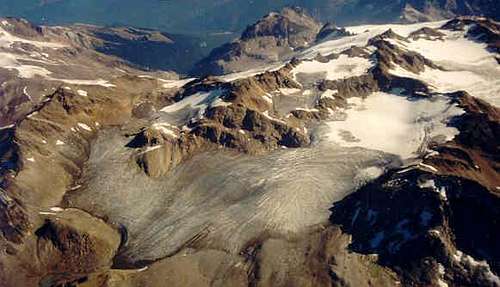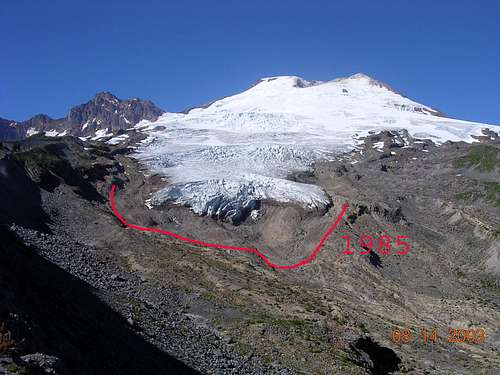Glacier Response to Climate Change
Glaciers respond to climate in an attempt to achieve equilibrium. A glacier advances due to a climate cooling/snowfall increase that causes positive mass balance. A climate warming/snowfall decrease leads to negative mass balances and glacier retreat. To reestablish equilibrium a retreating glacier must lose enough of its highest ablating sections, usually at the lowest elevations, so that accumulating snows near the head of the glacier once again are equivalent to overall ablation, and an equilibrium balance is approached. This is akin to a corporation layoff some workers or selling a poor division to try to return to profitability. If a glacier cannot retreat to a point where equilibrium is established, it is in disequilibrium with the climate system. That is it is bankrupt and will not survive.
The primary focus of attention has been on changes in terminus position of a glacier which tells us how the glacier is currently responding to recent climate. This portion of smaller alpine glaciers responds very quickly to climate. However, a glacier can retreat rapidly and still survive if it has an accumulation zone. Terminus behavior is not a good indicator of glacier survival.
For a glacier to survive it must have a consistent and persistent accumulation zone. Thus, to forecast survival we need to focus on the accumulation zone, not the terminus. If the accumulation zone no longer retains accumulation consistently it will begin to thin. Symptoms of accumulation zone thinning are: 1) The margins of the glacier in the accumulation zone-upper potion of the glacier recede. 2) New outcrops of rock maybe exposed in the accumulation zone due to thinning. 3) The upper portion of the glacier, what should be the accumulation zone, has little or no snowcover. This year was our 28th consecutive year measuring
North Cascade glaciers and the forecast method emerged from our mass balance observations. This behavior has been observed both in the North Cascades, Italian Alps and Swiss Alps.
Comparison of image pairs from the North Cascades of Washington will indicate if the top of the glacier is receding. For example Foss Glacier has considerable retreat even in the margin at the the head of the glacier and has little retained snowpack even in early August in many recent summers 2003, 2004, 2005, 2007 and 2009 for example.
![Foss Glacier]() Foss Glacier in 1985 and 2005, 40% area lost.
Foss Glacier in 1985 and 2005, 40% area lost. A view of the Columbia Glacier-title image from its head indicates nearly no residual snowcover even in early August in 2005. For Lynch Glacier the symptom is emergence of rocks at Point B in the image.
![Lynch Glacier Pair]() Lynch Glacier 1960 and 2008
Lynch Glacier 1960 and 2008 For Milk Lake Glacier the loss has already occurred, but in 1988 it was clear that no accumulation zone existed when we visited the glacier in early August.
![Milk Lake Glacier]() Milk Lake Glacier in 1988 and then in 2008 the basin devoid of a glacier, just a gorgeous new lake.
Milk Lake Glacier in 1988 and then in 2008 the basin devoid of a glacier, just a gorgeous new lake. For Whtiechuck Glacier there was not accumulation zone on the left arm of the glacier in 1988
![Whtichuck Glacier 1988]() Whtiechuck Glacier 1988
Whtiechuck Glacier 1988by 2003 it was gone.
![Whitechuck Glacier]() Whtiechuck Glacier 2003
Whtiechuck Glacier 2003
Easton Glacier on Mount Baker is not shrinking in the accumulation zone and is forecast to survive current climate.
![Easton Glacier]() Easton Glacier 2003
Easton Glacier 2003
This method of assessment needs to be done glacier by glacier whether you are in the Italian Alps, Peruvian Andes or Canadian Rockies. In Glacier National Park not all the glaciers lack a consistent accumulation zone, most did and have or are disappearing. Jackson Glacier is not retreating rapidly and still does have an accumulation zone.
![Jackson Glacier]() Jackston Glacier, Glacier National Park 1966 and 2005 boundary.
Jackston Glacier, Glacier National Park 1966 and 2005 boundary.
Now it your turn to examine those pictures of glaciers you have returned to and that seemed to be shrinking considerably. Let me know what their symptoms are.
External Links
Forecasting temperate alpine glacier survival from accumulation
zone observations
Glacier Mass balance and equilibrium or disequilibrium response
Donne Glacier Retreat
Helm Glacier Melting Away











Comments
Post a Comment